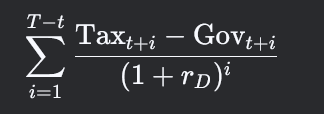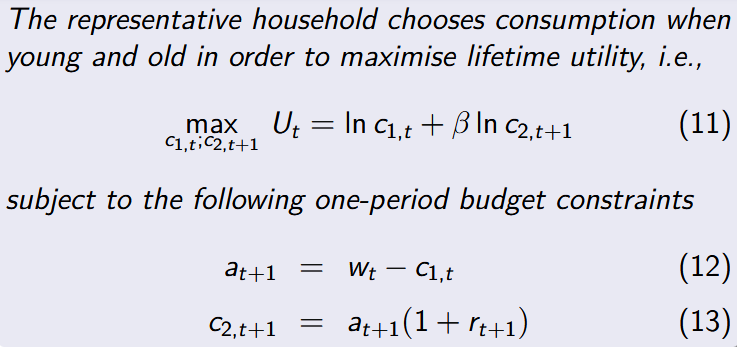Long Run Fiscal Policy
1/65
There's no tags or description
Looks like no tags are added yet.
Name | Mastery | Learn | Test | Matching | Spaced |
|---|
No study sessions yet.
66 Terms
2 key elements of government spending (denoted as Govt)
G in national income: expenditure on consumption and public capital
transfer payments eg pensions (affects C through change in disposable income)
page 2
how has Gov spending in OECD countries changed over last 100 years
grown a lot: increases in health, edu, social security along traditional spending like infrastructure
how does Gov spending redistribute resources
over lifetime (taxes when young, benefits when old)
across hh (progressive tax)
across generations (state pension system)
difference between Gt in national accounts and total Gov spending Govt
Gt only includes spending on GNS & public capital
Govt also includes transfer payments (that affect C through change in disposable income)
what are LRFP concerns related to population ageing
rising health/pension expenditures →.
how do debt crises manifest (3 reasons)
higher cost of borrowing
harder to borrow in financial markets
sell assets in home currency = depreciation of currency
Government per period budget constraint
page 8
what happens if Dt+1 > Dt (what does this mean in terms of debt, tax and govt
real debt increases due to the budget deficit the gov ran in period t+1
page 9
what is a primary budget deficit
Govt+1 > Taxt+1
how to obtain the Gov Intertemportal Budget Constraint (GIBC)
paeg 10
what does the present value of all primary surpluses mean in fiscal policy
measures whether future revenues can cover future spending
tax revenues - non interest gov spending from time t+1 onward using the borrowing rate rD as the discount factor

what happens if the present value of primary surpluses is too low relative to Dt
the gov is fiscally unsustainable→ cannot repay debt without:
raising future taxes (Taxt+i)
cutting spending (Govt)
defaulting
what is the no-ponzi condition definition
a rule that prevents the gov from perpetually rolling over debt without repaying it
value of the debt must eventually shrink to zero, meaning debt cant grow faster than the interest rate indefinitely

what happens if no ponzi condition is violated
gov engages in ponzi scheme and issues new debt to pay interest on old debt indefinitely
DT > Dt(1+rD)T−t
results in loss of creditor confidence, higher borrowing costs
why is the no ponzi condition economically necessary (3 reasons)
prevents explosive debt: debt can’t grow faster than GDP indefinitely
credibility: ensures lenders are repaid, maintaining market trust
sustainable: ties current debt to future fiscal capacity, not infinite borrowing
simple explanation of the GIBC
if debt today, need budget surplus in future
flexible in SR, disciplined in LR
interdependence of FP over time (borrow now = higher future taxes or lower future spending in future)

alternative way to write GIBC & what does it say
total tax revenues (present value of future planned taxes) must equal current debt + all future government spending (PV of future planned gov spending)

what’s happened to debt/gdp ratio (D/Y = d) for many countries since the FC
seen d increased above 100%
derive budget constraints from gov per period budget constraint using debt to gdp ratios
page 13
what happens to primary surplus to gdp ratio when government runs a balanced primary budget (spending = tax)
pst+1=0
what needs to happen to primary surplus to gdp ratio, real interest, growth for debt to gdp ratio to rise over time
primary surplus to gdp ratio = 0
real interest > economy growth rate
then dt+1 > dt
approximating r and g tilda (real interest rate and economy growth rate)
top of page 15
using approximations for i and r in debt to gdp ratio equation
page 15
show debt to gdp ratio if debt is stable & what does it show
page 15
all rates and ratios constant
when rD>econ growth rate, stabilising debt requires primary surplus
if econ growth rate>rD, can run a small deficit without debt growing
when is it easier to reduce d (look at change in debt to gdp ratio equation)
nominal interest is low
inflation is high
economy growing strongly
large primary surplus

HH problem in basic 2 period Overlapping Generation model (OLG model)
max lifetime utility over 2 periods
p18
get lifetime budget constraint from subbing constraints into each other
page 18

solve hh problem (max utility s.t. LBC) using lagrangian
page 19
maximising OLG on diagram
page 20
no adjustment costs meaning
firms maximise profits by choosing Kt and Lt, taking prices (rt + δ, wt) as given → rental cost of capital and wage rate respectively
work out MPLt and MPKt from cobb douglas production function
page 22
using no adjustment costs to find marginal products = to input prices equations
MPK = rt+δ
MPL = wt
page 22
what is the aggregate supply of capital
total assets held by young + total assets held by old
page 23
equilibrium supply of capital expression
page 23
obtain transition equation of OLG model
page 23
what does the transition equation of the OLG model show
equation links today’s capital (kt) to tomorrow’s (kt+1) through:
household savings into next period
firm investment
capital share, patience, growth rate of effective workers
OLG model on diagram (kt, kt+1 space)
page 26
how do gov fund spending
income tax
NICs = national insurance → funds state pensions
VAT
OLG model but giving workers a choice between labour/leisure & introducing taxes (and what are the constraints)
page 28
combining the constraints to get the LBC in the OLG model with tax and worker choice
page28
interpretation of LBC for OLG model with taxes and worker preferences for leisure (look at total effects for capital income tax & tax on wages)
page 29
LRFP with no debt and balanced budgets optimisation method
page 32
LRFP with no debt and balanced budgets obtaining transition equation
page 33
LRFP with no debt and balanced budgets - what does the transition equation tell us and what shifts it (and k*)
page 34
how do OLG model steady states differ with government and without government
with government = lower steady state due to tax rate
government spending and crowding out takeaways
crowding out: higher taxes reduce private savings and capital
but can improve welfare and even help private sector grow (eg roads make them more efficient)
what are the two types of government expenditure
Gt: make people happy but dont boost production (enter through hh utility)
Public capital KG,t: help businesses produce more (enter production function)
how does government finance spending (tax revenue)
page 37
results of the LR impact of Gov expenditure on consumption and public capital spending
consumption: crowding out but people get extra utility
public capital: can make capital more productive, but lower disposable income
page 37
what changes with LRFP with debt
government can now finance spending by accumulating debt
now, the capital equilibrium is Kt+1 + Dt = Lt at+1
means capital stock available in period t+1 equals total national net wealth (private sector wealth - government’s outstanding debt)
3 key points about debt
debt crowds out capital accumulation
debt has redistributional impact across generations
under certain circumstances, debt and taxes may be equivalent
page38
5 reasons for PAYG pension system
market failures
behavioural issues
free riding
redistribution across generations
redistribution within generations
pension systems by funding structure
fully funded system - pensions come from invested savings from fund - less burden on future taxpayers but market risks
PAYG - workers pay taxes to fund today’s retirees - no market risk but may struggle if population ages (less workers per retiree)
pension structures by payout rules
defined contribution - save fixed % of salary
defined benefit - pension based on salary/years worked
balanced & sustainable PAYG system
total amount of contributions by young = total amount of benefits received by old
paGE 40
households maximisation problem + constraints (PAYG Pension System)
p40
steady state PAYG system (economy growth rate needs to keep up with pensions)
page 40
what do aging populations force upon pension systems
increased tax for young, lower pensions for old
solve hh maximisation problem with pensions (combine constraints and use bt+1 = (1+gtilda)tax x wage
page 41
what do pension taxes do to consumption in period 1,2, savings and capital accumulation
page 41
why is PAYG inefficient if r> gtilda (explain what r>g tilda means as well)
page 42
why do govs still use PAYG when r>g tilda
redistribution: transfers wealth to low earners who wouldn’t save enough privately
private pensions might not protect against longevity risk
how funded systems are different to PAYG
pension is bt+1 = (1+r)θbwt
(no dependency on g tilda and no crowding out because savings earn r but expose retirees to market risk)
page 43
tax wedge from payg
page 42
challenges in reforming PAYG
transaction costs
risk: demographic shocks eg aging population
risks of funded pension systems
market volatility
complicated
but better in LT → shift PAYG to funded where possible